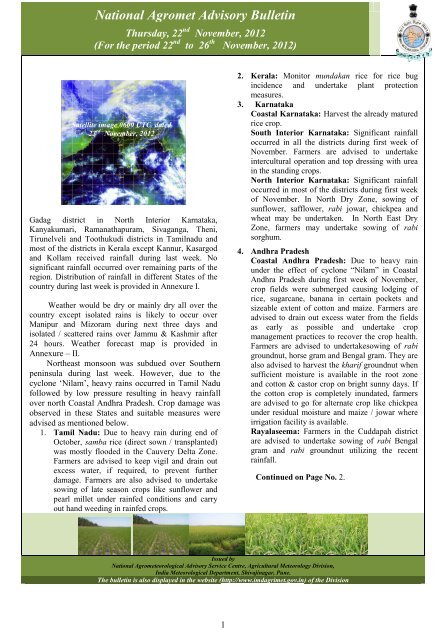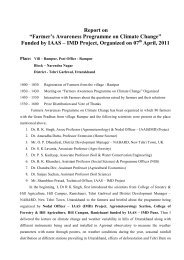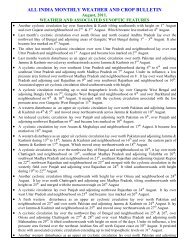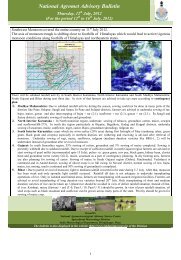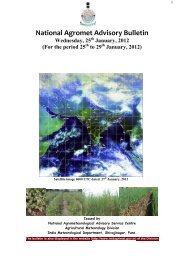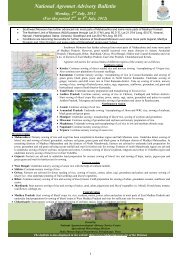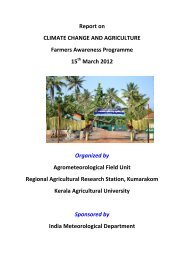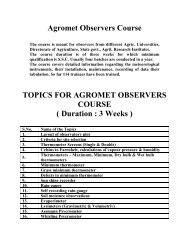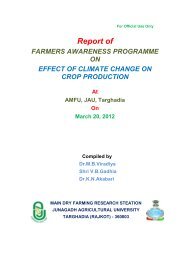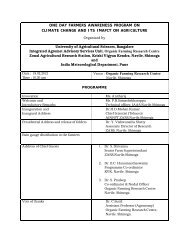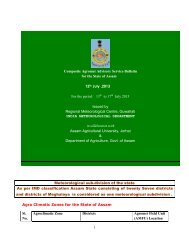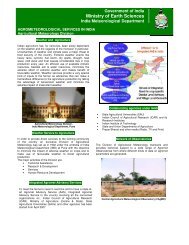Bulletin 22.11.pdf - Agricultural Meteorology Division
Bulletin 22.11.pdf - Agricultural Meteorology Division
Bulletin 22.11.pdf - Agricultural Meteorology Division
You also want an ePaper? Increase the reach of your titles
YUMPU automatically turns print PDFs into web optimized ePapers that Google loves.
National Agromet Advisory <strong>Bulletin</strong>Thursday, 22 nd November, 2012(For the period 22 nd to 26 th November, 2012)Satellite image 0600 UTC dated23 rd November, 2012Gadag district in North Interior Karnataka,Kanyakumari, Ramanathapuram, Sivaganga, Theni,Tirunelveli and Toothukudi districts in Tamilnadu andmost of the districts in Kerala except Kannur, Kasargodand Kollam received rainfall during last week. Nosignificant rainfall occurred over remaining parts of theregion. Distribution of rainfall in different States of thecountry during last week is provided in Annexure I.Weather would be dry or mainly dry all over thecountry except isolated rains is likely to occur overManipur and Mizoram during next three days andisolated / scattered rains over Jammu & Kashmir after24 hours. Weather forecast map is provided inAnnexure – II.Northeast monsoon was subdued over Southernpeninsula during last week. However, due to thecyclone ‘Nilam’, heavy rains occurred in Tamil Nadufollowed by low pressure resulting in heavy rainfallover north Coastal Andhra Pradesh. Crop damage wasobserved in these States and suitable measures wereadvised as mentioned below.1. Tamil Nadu: Due to heavy rain during end ofOctober, samba rice (direct sown / transplanted)was mostly flooded in the Cauvery Delta Zone.Farmers are advised to keep vigil and drain outexcess water, if required, to prevent furtherdamage. Farmers are also advised to undertakesowing of late season crops like sunflower andpearl millet under rainfed conditions and carryout hand weeding in rainfed crops.2. Kerala: Monitor mundakan rice for rice bugincidence and undertake plant protectionmeasures.3. KarnatakaCoastal Karnataka: Harvest the already maturedrice crop.South Interior Karnataka: Significant rainfalloccurred in all the districts during first week ofNovember. Farmers are advised to undertakeintercultural operation and top dressing with ureain the standing crops.North Interior Karnataka: Significant rainfalloccurred in most of the districts during first weekof November. In North Dry Zone, sowing ofsunflower, safflower, rabi jowar, chickpea andwheat may be undertaken. In North East DryZone, farmers may undertake sowing of rabisorghum.4. Andhra PradeshCoastal Andhra Pradesh: Due to heavy rainunder the effect of cyclone “Nilam” in CoastalAndhra Pradesh during first week of November,crop fields were submerged causing lodging ofrice, sugarcane, banana in certain pockets andsizeable extent of cotton and maize. Farmers areadvised to drain out excess water from the fieldsas early as possible and undertake cropmanagement practices to recover the crop health.Farmers are advised to undertakesowing of rabigroundnut, horse gram and Bengal gram. They arealso advised to harvest the kharif groundnut whensufficient moisture is available in the root zoneand cotton & castor crop on bright sunny days. Ifthe cotton crop is completely inundated, farmersare advised to go for alternate crop like chickpeaunder residual moisture and maize / jowar whereirrigation facility is available.Rayalaseema: Farmers in the Cuddapah districtare advised to undertake sowing of rabi Bengalgram and rabi groundnut utilizing the recentrainfall.Continued on Page No. 2.Issued byNational Agrometeorological Advisory Service Centre, <strong>Agricultural</strong> <strong>Meteorology</strong> <strong>Division</strong>,India Meteorological Department, Shivajinagar, Pune.The bulletin is also displayed in the website (http://www.imdagrimet.gov.in) of the <strong>Division</strong>1
16. Rajasthan: Start sowing of wheat, barley, maize, taramira, toria, pea, rainfed gram, mustard,vegetables like carrot, spinach and radish. Undertake Autumn planting of sugarcane. Continueharvesting of bajra and kharif pulses.17. Uttar Pradesh: Farmers are advised to complete land preparation and sowing of mustard, pea, lentil,gram, lucerne, oats and senji crops. Complete planting of potato and sugarcane along with intercropslike wheat, barley, raya, toria, gobhi sarson etc., vegetables like tomato, raddish, carrot, palak,cauliflower, cabbage etc. Apply irrigation to vegetable crops and already sown rabi crops. Completeharvesting of matured rice.18. Gujarat: Farmers are advised to undertake sowing of coriander, cumin and wheat as temperature isdecreasing. Undertake harvesting of groundnut and cotton and sowing of rabi maize, gram andmustard. Complete transplanting of cabbage, cauliflower and onion. Also undertake transplanting ofbrinjal, and sowing of onion, radish, garlic and fenugreek.19. Maharashtra: As mainly dry weather is expected to prevail in Maharashtra during the period, farmersare advised to continue picking of fully opened cotton bolls. Also continue sowing of rabi jowar, maizeand irrigated gram, wheat and short duration crops like cowpea, wal, kulthi utilising residual moisturein the harvested rice field; complete planting of pre-seasonal sugarcane and water melon on one side ofthe ridge.20. Madhya Pradesh: Farmers in Madhya Pradesh are advised to undertake sowing of rabi crops likechickpea, lentil, mustard, linseed and pea. Continue sowing of rabi vegetables and planting of potato,sugarcane and garlic.21. Chhattisgarh: Present weather conditions are suitable for sowing of wheat, sugarcane, cabbage,tomato, brinjal, niger, horse gram, lobia, chilli, gram, pea, mustard and linseed. Undertake transplantingof vegetables, planting of cassava, colocasia, ginger, elephant foot yam and diascorea and providesupport with bamboo sticks.3
Contour maps for Mean Maximum and Minimum Temperature and their anomaly for the weekending on 21.11.2012Actual Mean Maximum temperature ranged between 32to 36 0 C over many parts of Gujarat, Saurashtra & Kutch,Lakshadweep Islands, some parts of West Rajasthan,Coastal Andhra Pradesh, Raylaseema, Tamil Nadu,Kerla, Andaman & Nicobar Islands, 24 to 28 0 C over ofmany parts of Uttarakhand, Arunachal Pradesh, EastMadhya Pradesh, Chattisgarh, Jharkhand, some partsJammu & Kashmir, Himachal Pradesh, Uttar Pradesh,Punjab, Assam, Manipur, Mizoram, Bihar, GangeticWest Bengal, West Madhya Pradesh, Marathwada,Karnataka, Andaman & nicobar Islands, 20 to 24 0 C overof many parts of Bihar, Jharkhand, Sub-Himalayan WestBengal & Sikkim, Assam & Meghalaya, Mizoram,Tripura, some parts of Jammu & Kashmir, HimachalPradesh, Jharkhand, Gangetic West Bengal, Tripura, 28to 32 0 C over remaining parts of the country.Actual Mean Maximum temperature anomaly rangedbetween 2 to 4 0 C over many parts of Nagaland, some partsof Jammu & Kashmir, Himachal Pradesh, ArunachalPradesh, Assam, Manipur, Coatal Andhra Pradesh,Raylaseema, Tamil Nadu, Lakshadweep Islands, 0 to 2 0 Cover many parts of Jammu & Kashmir, Himachal Pradesh,Uttrakhand, East Rajasthan, West Bengal & Sikkim,North East (except Nagland), South India,Maharashtra(except Vidarbha), Lakshadweep, Andaman &Nicobar Islands, some parts of West Rajasthan, Haryana,Bihar, -4 to -2 0 C over many parts of Orissa, some parts ofChattisgarh, -2 to 0 0 C over rest of the country.Actual Mean Minimum Temperature ranged between 24 to28 0 C and above over some parts of Andhaman & NicobarIslands, 20 to 24 0 C over many parts of Lakshadweep,Andhaman & nicobar Islands, 12 to 16 0 C over many partsof Rajasthan, Haryana, Delhi, Gujarat, West MadhyaPradesh, Bihar, Jharkhand, Sub-Himalayan West Bengal,North East India(except Tripura), Chattisgarh, Telangana,North & South Interior Karnataka, Marathwada, Vidarbha, ,some parts of Jammu & Kashmir, Himachal Pradesh,Punjab, East Madhya Pradesh, Orissa, Tamil Nadu, Kerla,and between 16 to 20 0 C over remaining parts of thecountry.Minimum Temperature anomaly ranged above 0 to 2 0 Cover many parts of Jammu & Kashmir, HimachalPradesh, West Rajasthan, Gangetic West Bengal,Mizoram, Tripura, Andaman & Nicobar Islands someparts of Jharkhand, Mizoram, Orissa, Coastal AndhraPradesh, -4 to -2 0 C over many parts of East Uttar Pradesh,Sub-Himalayan West Bengal & Sikkim, ArunachalPradesh, Assam & Meghalaya, East Madhya Pradesh,Gujarat,Telangana, Tamil Nadu, Gujarat, some parts ofBihar, Chattisgarh, Mahrashtra, Coastal Andhra Pradesh,Raylaseema, Karnataka, West Madhya Pradesh, -2 to 0 0 Cover remaining parts of the country.4
Distribution of rainfall of the country during week ending on 21.11.2012State/Districts Actual 21.11.12KarnatakaCoastal KarnatakaDakshin Kannada 0.0 -100Udupi 0.0 -100Uttar Kannada 0.0 -100North Interior KarnatakaBagalkote 0.0 -100Belgaum 0.0 -100Bidar 0.0 -100Bijapur 0.0 -100Dharwad 0.0 -100Gadag 0.0 -100Gulbarga 0.0 -100Haveri 0.0 -100Koppal 0.0 -100Raichur 0.0 -100Yadgir 0.0 -100South Interior KarnatakaBangalore Rural 0.0 -100Bangalore Urban 0.0 -100Bellary 0.0 -100Chamarajnagar 0.0 -100Chichballapur 0.0 -100Chickmagalur 0.0 -100Chitradurga 0.0 -100Davangere 0.0 -100Hassan 0.0 -100Kodagu 0.0 -100Kolar 0.0 -100Mandya 0.0 -100Mysore 0.0 -100Ramnagara 0.0 -100Shimoga 0.0 -100Tumkur 0.0 -100KeralaAlappuzha 0.0 -100Kannur 0.0 -100LegendsErnakulam 0.0 -100Idukki 0.0 -100Kasaragod 0.0 -100Kollam 2.8 -93Kottayam 0.0 -100Kozhikode 0.0 -100Malappuram 0.0 -100Palakkad 0.0 -100Pathanamthitta 0.0 -100Thiruvanantapuram 9.1 -74Thrissur 0.0 -100Wyanad 0.0 -100Tamil NaduAriyalur 0.0 -100Chennai 0.0 -100Coimbatore 0.0 -100Cuddalore 0.0 -100Dharmapuri 0.0 -100Dindigul 0.0 -100Erode 0.0 -100Kanchipuram 0.0 -100Kanyakumari 18.7 -51Karikal 0.0 -100Karur 0.0 -100Krishnagiri 0.0 -100Madurai 0.0 -100Nagapattinam 0.0 -100Namakkal 0.0 -100Nilgiris 0.0 -100Perambalur 0.0 -100Puducherry 0.0 -100Pudukottai 0.0 -100Ramanathapuram 0.0 -100Salem 0.0 -100Sivaganga 0.0 -100Thanjavur 0.0 -100Theni 0.0 -100Tirunelveli 11.9 -70Tirupur 0.0 -100(20% or more) excess rainfall (-60 to -99 %) scanty rainfall(-19 to +19%) normal rainfall (-100%) no rainfall(-20 to -59%) deficient rainfall ** Data not availableTiruvallur 0.0 -100Tiruvannamalai 0.0 -100Tiruvarur 0.0 -100Toothukudi 0.0 -100Trichy 0.0 -100Vellore 0.0 -100Villupuram 0.0 -100Virudhunagar 0.0 -100Andhra PradeshCoastal Andhra PradeshEast Godavari 2.1 -86Guntur 0.6 -96Krishna 0.9 -92Nellore 0.0 -100Prakasam 0.1 -99Sirkakulam 0.1 -98Visakhapatnam 0.3 -98Vizianagram 0.0 -99West Godavari 1.4 -89TelanganaAdilabad 0.0 -100Hyderabad 0.0 -100Karimnagar 0.0 -100Khammam 0.3 -94Mehabubnagar 0.0 -100Medak 0.0 -100Nalgonda 0.0 -100Nizamabad 0.0 -100Rangareddy 0.0 -100Warangal 0.0 -100RayalaseemaAnantapur 0.0 -100Chittoor 0.0 -100Cuddapah 0.0 -100Kurnool 0.0 -1005
Weather Forecast(Valid upto 0830 hours of 25 th November, 2012)Major Feature of Weather Forecast up to 0830 hours IST of 25 th November, 2012Rain/snow would occur at one or two places over Jammu & Kashmir during next 48 hours and at afew places thereafter. Rain/snow would also occur at one or two places over Himachal Pradesh andUttarakhand.Rain/thundershowers would occur at many places over coastal Andhra Pradesh during next 48 hoursand decrease thereafter.Rain/thundershowers would occur at a few places over northcoastal Tamilnadu, Rayalaseema and atone or two places over rest Tamilnadu and Kerala during next 24 hours and increase thereafter.Rain/thundershowers would occur at one or two places over coastal & south interior Karnataka andLakshadweep tomorrow onwards.Rain/thundershowers would occur at one or two places over northeastern states from 23 rd onwards.Rain/thundershowers would occur at a few places over Andaman & Nicobar Islands.No significant change in maximum and minimum temperatures over northwest and central India.Weather would be mainly dry over rest parts of the country.Weather Warning during next 3 daysHeavy rainfall would occur at one or two places over southcoastal Andhra Pradesh and northcoastalTamilnadu during next 24 hours.WeatherWeather Outlook for subsequent 4 days up to 0830 hours IST of 29 th November, 2012Rain/thundershowers would occur at a few places over south peninsular India and Lakshadweep.Rain/snow would occur at one or two places over western Himalayan region.Rain/thundershowers would occur at one or two places over northeastern states.6
Zonewise Agromet AdvisoriesNORTHEAST INDIA [ARUNACHAL PRADESH, NMM&T, ASSAM, MEGHALAYA] Realised Rainfall: Mainly dry weather prevailed over most of the districts of the States of the regionduring last week. Rainfall Forecast: Rain/thundershowers would occur at one or two places over northeastern states from23 rd onwards. .Advisories:‣ As there was no significant rain over most of the districts of the States of the region during lastcouple of weeks and no significant rain is likely to occur during the period, farmers are advised toapply irrigation to the standing crops.‣ Farmers in North Bank Plain Zone and Hill Zone of Assam are advised for nursery raising of bororice. Also undertake land preparation and sowing of rapeseed, mustard and lentil, planting of potatoand transplanting of the seedlings of winter vegetables. Undertake transplanting of 4-6 weeks oldseedlings of vegetables in the main field.‣ Farmers in Lower Brahmaputra Valley Zone of Assam are advised to undertake land preparation andsowing of cauliflower, cabbage, knolkhol, rabi maize, rapeseed and mustard and planting of potatoand improved varieties of tomato.‣ Farmers in Upper Brahmaputra Valley Zone of Assam are advised to undertake sowing of brinjal,knolkhol and transplanting of seedlings of cauliflower and cabbage. Farmers are also advised toundertake land preparation and sowing of rapeseed and mustard.‣ Farmers in Hill Temperate Zone of Assam are advised to drain out the excess water from the Salipaddy field at hard dough stage for proper maturity and harvest the already matured rice crop.Undertake land preparation and sowing of rapeseed and mustard and planting of potato. Farmers arealso advised to undertake sowing of cauliflower, cabbage, knolkhol, brinjal and tomato.‣ Farmers in Central Brahmaputra Valley Zone of Assam are advised to undertake land preparation andsowing of rabi crops (kitchen garden, cole crops, rapeseed and mustard and wheat). The seedlings ofcole crops may be transplanted when they become 30-35 days old. Farmers are also advised toprepare land and undertake planting potato.‣ Farmers in Barak Valley Zone of Assam are advised to undertake transplanting of seedlings of brinjaland planting of potato in the main field. Farmers are also advised to undertake field preparation andplanting of sugarcane setts (autumn planting). Select upland sandy loam soil for the cultivation ofcauliflower.‣ Farmers in Sub Tropical Hill Zone of Arunachal Pradesh are advised to maintain proper moisturelevel in cauliflower, cabbage, broccoli and knolkhol fields. Farmers are also advised to prepareseedbed of tomato and raddish.‣ In Mild Tropical Hill Zone of Mizoram, farmers are advised to harvest Khasi Mandarin orange whencolour changes and undertake preparation for nursery of cole crops in rain sheltered area.‣ In Mild Tropical Hill Zone of Nagaland, farmers are advised to harvest jhum rice and wetland rice.Farmers are also advised for land preparation and transplanting of the seedlings of tomato andcabbage.‣ Farmers in Sub Tropical Plain Zone of Manipur are advised to undertake land preparation and sowingof maize, pea and zero tillage rapeseed and planting of potato. Farmers are also advised to undertaketransplanting of the seedlings of cabbage, cauliflower, broccoli, onion etc.‣ In Temperate Sub Alpine Zone of Meghalaya, farmers are advised to undertake nursery raising aswell as transplanting of cole crops and other winter vegetables. Farmers are also advised to undertakesowing of rabi maize in low and medium altitude regions.‣ In Mild Tropical Plain Zone of Tripura, farmers are advised to start intercultural operation likethinning and weeding in rabi maize. Farmers are also advised to undertake sowing of toria and lentil.‣ Suitable varieties of the crops for sowing or transplanting are mentioned in Annexure II.‣ In Central Brahmaputra Valley Zone, Gundhi bug infestation is observed in sali rice; ApplyMalathion 5% dust @ 20 kg / ha.‣ In Mid Tropical Hill zone of Mizoram, there is chance of attack of collar rot and rhizome rot inginger and turmeric. Spraying with copper fungicide or combination of Metalaxyl + Mancozeb @ 2.57
g / litre of water or soil drenching with 1% Bordeaux mixture to control Collar rot and spraying withCopper Oxychloride @ 3 g / litre of water to prevent rhizome rot disease may be done.‣ Stages of major crops are mentioned in Annexure I.Animal Husbandry‣ In North Bank Plain Zone and Bramhaputra Valley Zone of Assam and Sub Tropical Plain Zone ofManipur and Mid Tropical Zone of Tripura, farmers are advised to vaccinate cattle, pigs andbuffaloes against FMD, HS, BQ as well as anthrax disease.‣ In Mild Tropical Hill Zone of Mizoram and Sub Tropical Plain Zone of Manipur, farmers are advisedto deworm cattle against Fascioliosis and Endoparasite, vaccinate poultry against Ranikhet andCoccidiosis, deworm pigs and vaccinate against swine fever.EAST INDIA [JHARKHAND, BIHAR, ORISSA, WEST BENGAL & SIKKIM] Realised rainfall: Mainly dry weather prevailed over the States of the region. Rainfall Forecast: Weather will be mainly dry / dry over the region during the period. Advisories:‣ Farmers are advised to apply irrigation to the standing crops in Jharkhand, Bihar, West Bengal andSikkim as there was no significant rainfall in most of the districts in States of the region and mainly dry/ dry weather is likely during next three days.‣ In South Bihar Alluvial Zone, farmers are advised to harvest matured short duration rice crop and toprepare field for sowing of gram, lentil, peas, sunflower and mustard. Prepare nursery bed withrecommended dose of fertilizers for sowing of autumn planted tomato, cauliflower, chillies, palak,carrot, radish, knol khol, turnip, beet, garlic and cabbage. Prepare field for sowing of irrigated, nonirrigatedwheat, oat and maize crop.‣ In North West Alluvial Plain Zone of Bihar, farmers are advised to harvest matured rice crop andundertake planting of potato. Farmers are advised to continue sowing of rabi maize and other crops.Temperature condition is favourable for sowing of pea and lentil crop. Undertake sowing of gram andrajmah. Temperature condition is favorable for cultivation of Oyster mushroom.‣ In North East Alluvial Zone of Bihar, farmers are advised to use broad spectrum fungicide in treatmentof seed. Use bio fertilizer before sowing of rabi crop. Grow indigenous as well as improved fodder cropfor production of green fodder.‣ Farmers in Western Undulating Zone of Orissa are advised to prepare land to sow groundnut andmustard.‣ Farmers of Western Undulating Zone are advised to prepare land for sowing of rabi oilseed likegroundnut and mustard.‣ Farmers of East and South Eastern Coastal Plain Zone of Orissa are advised to drain out water bothfrom paddy and non-paddy field. Harvesting of paddy, pulses, sunflower, maize, mustard andgroundnut may be continued. Go for sowing of garlic in irrigated upland and medium land, wheatsowing in inland districts, planting of potato, sowing of mustard under rainfed condition and sowing ofirrigated groundnut. Farmers of North Central Plateau Zone of Orissa are advised that sowing of mustard and groundnut maybe completed immediately. Weather is optimum for sowing of sunflower, onion and garlic in irrigatedupland and medium land. Farmers of North Eastern Coastal Plain Zone are advised for planting of tomato, cabbage & cauliflowermay be done. Land preparation for groundnut may be started in uplands. Farmers of Mid Central Table Land Zone of Orissa are advised to start sowing of sugarcane, blackgramand greengram. Farmers of North Eastern Plateatu Zone of Orissa are advised to complete groundnut sowing before theend of the month in the water available area. Start transplanting of winter vegetables like cauliflower,cabbage, chilli tomato, brinjal etc with suitable seedlings. Spray bioinsecticide like Halt or Delfin @ 1gm per litre of water to control different insects in cauliflower and cabbage. Farmers of North Eastern Ghat Zone of Orissa are advised for sowing of rainfed groundnut and greenpea in the fallow uplands and sowing of sesame. Farmers of West Central Table Land Zone of Orissa are advised to go for land preparation for sowing ofrainfed groundnut and sesame. Harvest the matured kharif groundnut, green gram and black gram.8
‣ In Jharkhand, farmers are advised to plough the land immediately utilizing the soil moisture and sowthe different rabi crops with assured irrigation facility.‣ Farmers in Central and North Eastern Plateau Zone in Jharkhand are advised to undertake piaracropping, if there is sufficient moisture. Sowing of piara crop – gram, linseed, lentil and field pea maybe sown in standing crop rice by increasing the seed rate by 1.5 times. Harvesting of matured rice maybe done. Undertake sowing of improved varieties of gram as single crop or intercropping with linseed ormustard. Cultivate improved varieties of lentil, toria, mustard, green pea, tomato, cabbage, cauliflower,potato. Raise improved varieties of onion seedlings and prepare nursery bed.‣ In Western Plateau Zone of Jharkhand, farmers are advised to prepare the land immediately afterharvesting of rice and sow wheat crop. Farmers are advised to sow kulthi, green pea and Africanmarigold or French marigold. Farmers are advised to sow rabi crops like gram, lentil, linseed, pea,mustard, barley etc. and undertake planting of potato.‣ In Coastal Saline Zone of West Bengal, farmers are advised to start sowing of black gram in paddyfield. Maintain proper aeration in the field of betel vine.‣ In New Alluvial Zone of West Bengal, farmers are advised to harvest early transplanted aman rice andmaintain proper drainage for mature rice field. Farmers are also advised to complete land preparation forpotato sowing and apply 1.5- 2 ton cow dung manure or compost manure for a bigha before landpreparation.‣ Farmers in Laterite and Red Soil Zone of West Bengal are advised to start sowing of potato and beforesowing seeds should be dipped in Bavistin solution for 10 minutes. In winter vegetables, apply 44 kg ofurea and 50 kg of MoP, 21 days after sowing of seeds. Farmers are also advised to planting of winterseason gladiolus.‣ Farmers in Old Alluvial Zone of West Bengal are advised to undertake land preparation and sowing ofwheat and mustard and start seedbed preparation for sowing of tomato.‣ Farmers in Terai Zone of West Bengal are advised to prepare main field for planting cauliflower, cabbage,brinjal and tomato. Farmers are also advised for transplanting of winter seasonal flowers like gladiolus andharvest short duration aman rice.‣ Suitable varieties of the crops for sowing or transplanting are mentioned in Annexure II.‣ BPH and sheath blight occurrence is reported in Western Undulating Zone of Orissa during this periodin some areas. For control of BPH, basal spraying of Buprofezin @ 1.5 ml / litre of water orImidacloprid @ 1 ml / 4 litre of water may be carried out. Alternate wetting and drying of field shouldbe done.‣ Infestation of pod borer has been found and blister beetle may be severe in arhar. Farmers of NorthEastern Ghat Zone (G.Udaygiri) of Orissa are advised to spray 200 ml Endosulphan along with 200Neem based pesticides in 200 litre water for pod borer and spray 2 ml Neem oil along with 1 mlEndosulphan in 1 litre water thrice at an interval of one week in North Eastern Ghat Zone.‣ Fruit and shoot borer has been found in brinjal in West Central Table Land Zone of Orissa, installpheromone traps. Alternately spray 4g Sevin and 2ml Malathion in one litre water in 7 days interval.‣ Due to favourable weather condition, in New Alluvial Zone of West Bengal, there is chance of attackof fungal root rot disease in tomato and brinjal. Before transplanting dip the roots of seedling to thesolution of Carbendazim 12% + Mancozeb 63% @ mixture (2 gm per litre of water).‣ Gundhi bug and brown plant hopper has been found in rice in Coastal Saline Zone of West Bengal.Spray Imidachlorpid 17.8 S.L. @3ml/liter of water or Buptofezin 25 E.C.@2ml/liter of water to controlattack.‣ Under present hot and humid situation in Laterite and Red soil Zone of West Bengal, brown planthopper or stem borer may attack in aman rice. Spray mancozeb 1.5ml per lit and Carbosulphan 25EC@2 ml per lit of water to control attack.‣ Animal Husbandry‣ Foot and mouth disease has been observed in cows in North Eastern Plateau Zone of Orissa, farmersare advised to apply potassium permanganate on lesions in the mouth and sulphur treatment isrecommended for foot lesions.‣ Farmers of Western Undulating Zone of Orissa are advised to vaccinate cattle with intramuscular QilAdjuvant FMD vaccine @2ml per one cattle and @1ml per one sheep or goat as a preventive againstFMD during the winter season. The poultry should be vaccinated with R 2 b strain RD vaccine as apreventive against Ranikhet Disease and administered @0.5ml per bird subcutaneously.9
‣ Pisiculture‣ Farmers of North Eastern Plateau Zone of Orissa are advised that apply CIFAX 400ml/ha ml of wateras prophylactic measures against diseases. Apply Lime @ 250kg/ha.‣ Stages of major crops are mentioned in Annexure I.WEST INDIA [GOA, MAHARASHTRA, GUJARAT] Realised Rainfall: Mainly dry weather prevailed over the States of the region. Rainfall Forecast: Dry or mainly dry weather would prevail over the States of the region. Advisories:‣ As dry weather prevailed during last week and mainly dry weather is expected during next 5 days, farmers areadvised to apply irrigation to sugarcane, vegetables, early sown jowar and maize in Madhya Maharashtra,Marathwada and West Vidarbha.‣ Farmers in Konkan are advised to undertake sowing of short duration crops like cowpea, wal, kulthi on residualmoisture in the harvested rice field of rice under 'vapsa' condition. They are also advised to undertake sowing ofwater melon on one side of the ridge at a spacing of 4m x 1m.‣ As late varieties of rice are in grain maturity stage, farmers are advised to complete harvesting of already maturedcrop.‣ Prevailing cold and dry weather is favourable for sowing of rabi gram and wheat. Farmers in MadhyaMaharashtra are advised to continue sowing of irrigated gram and wheat.‣ Under prevailing weather farmers in Madhya Maharashtra and Marathwada are advised to complete the plantingof pre seasonal sugarcane.‣ As mainly dry weather is expected in maharashtra during next 5 days, farmers in Madhya Maharashtra,Marathwada and Vidarbha are advised to continue picking of fully opened cotton bolls. They are also advised tostore cotton of first and second picking separately.‣ As there are chances of decrease in temperature in North Gujarat Zone during coming week whichprovide favourable condition for rabi sowing, carry out sowing of rabi crops with assured irrigationfacilities. Undertake transplanting of cabbage, brinjal, cauliflower and sowing of onion, raddish andgarlic.‣ Farmers in South Gujarat Zone are advice to give half dose of nitrogen and full dose of phosphorus andpotash of recommended dose before sowing of wheat. They are also advised to make mulching insugarcane crop with its leaves for control of stem borer and to conserve moisture in the field.‣ Farmers in Middle Gujarat Zone are advised to sow wheat. Undertake sowing of spice crops likefenugreek, coriander and cumin. Undertake sowing of rabi maize, gram and harvesting of groundnut andcotton.‣ Undertake sowing of gram in North Saurashtra Zone, if 2-3 irrigation facilities are available. Sowing ofcumin and wheat may be carried out as temperature goes down. Complete harvesting of groundnut.Apply irrigation in alternate bed to cotton crop.‣ Carry out sowing of wheat and mustard in Bhal and Coastal Zone of Gujarat. Complete thetransplanting of cabbage, cauliflower and onion. Carry out intercultural operation or hand weeding inbrinjal and tomato.‣ Complete sowing of wheat in North West Zone of Gujarat. Apply light irrigation to cumin crop.Complete sowing of mustard if there is facility of irrigation.‣ Stages of the crops are mentioned in Annexure I.‣ As the atmosphere is favourable for mealy bug in cotton in South Gujarat Zone, farmers are advised tospray 50% wettable Carbaril @ 40 g or Profenphos 50 EC @ 10 ml or Quinalphos 20 EC @ 20 ml with10 g detergent powder in 10 liters of water.‣ Prevailing weather is congenial for incidence of oily spots on mrigbahar fruit of pomegranate in Marathwadaregion; spray Bordeaux mixture 1% or Copper oxychloride @ 25 g in 10 litres of water.‣ There may be attack of tea mosquito bug, leaf miner and leaf cutting / eating beetle on cashew, which is in newflush and flowering stage in some parts of South Konkan; spray Monocrotophos 36 % @ 14 ml per 10 litres ofwater.‣ There may be attack of pod borer in red gram in Pune <strong>Division</strong>; spray Heliokil @ 200 ml / acre in 200 litres ofwater.10
‣ Under prevailing weather there may be incidence of blight and thrips in onion in Western Maharashtra ScarcityZone; spray Chlorothalonil @ 25 g or Mancozeb @ 25 g plus Carbosulfan @ 10 ml or Fipronil + sticker @ 10 mlin 10 litres of water.‣ Varieties of rabi crops are mentioned in Annexure II. Animal Husbandry:‣ Cut the beaks of birds in the poultry under age of 15 Weeks. Entry of visitors in poultry should beprevented. Rats in the poultry should be destroyed. Clean udder of milking Animals with insecticide,zinc oxide or boric powder in North West Zone of Gujarat.NORTHWEST INDIA [JAMMU & KASHMIR, HIMACHAL PRADESH, UTTARAKHAND, PUNJAB,HARYANA, DELHI, UTTAR PRADESH & RAJASTHAN] Realised Rainfall: Mainly dry weather prevailed over the States of the region. Rainfall Forecast: Rain/snow would occur at one or two places over Jammu & Kashmir during next 48hours and at a few places thereafter. Rain/snow would also occur at one or two places over HimachalPradesh and Uttarakhand. Weather would be mainly dry over the remaining parts of the region. Advisory:‣ As no significant rainfall occurred over the States of the region and one or two places over Jammu &Kashmir during next 48 hours and Himachal Pradesh & Uttarakhand would occur during the period,farmers are advised to apply irrigation to the standing crops in the region.‣ Farmers in Flood Prone Eastern plain zone of East Rajasthan are advised to prepare field for sowing ofrabi crops like wheat, mustard, barley, potato and lentil and sow seeds in nursery for raising seedling ofautumn vegetables like tomato, brinjal, cauliflower, cabbage and radish.‣ Farmers in Semi-arid Eastern plain zone of Jaipur of East Rajasthan are advised to complete the sowingof mustard & gram at the earliest and start field preparation for the sowing of rabi crops like wheat,barley. Undertake planting nursery of late cauliflower, cabbage & rabi onion. Start sowing offenugreek, cumin, Isabgol, ajwain, carrot, radish & garlic may be continued.‣ In Arid Western Plain Zone Bikaner of West Rajasthan, farmers are advised to undertake the harvestingof matured late sown kharif crops, also undertake sowing of barley and wheat.‣ In Arid Western Plain Zone Jodhpur of West Rajasthan, farmers are advised to complete the sowing ofmustard and for sowing of wheat and barley field preparation may be undertaken and also sowing ofvegetables.‣ In Transitional plain zone of Inland Drainage of Rajasthan, farmers are advised to start for sowing oftaramira, toria, pea rainfed gram and mustard and vegetables like carrot, spinach and radish.‣ In irrigated northwestern plain zone of west Rajasthan, farmers are advised to continue sowing of wheat,gram and barley and complete the sowing of mustard.‣ In Sub Humid Southern Plain and southern humid plain zone of Rajasthan, farmers are advised to startpreparation of field for sowing of rabi crops like wheat, barley and gram. Sowing of opium poppyshould also be started during this week. Complete the planting of autumn sugarcane.‣ In southeastern humid plain zone of East Rajasthan, farmers are advised to start field preparation forsowing wheat, gram and mustard. Also advised to start sowing of winter maize in irrigated conditions.Autumn planting of sugarcane may be completed.‣ In sub tropical zone of Jammu & Kashmir, farmers are advised to do sowing of wheat, gram, barley, rabioilseeds, pulses and vegetables like radish, carrot, garlic, spinach and methi without any further delayand continue harvesting of early maturity varieties of rice.‣ In Intermediate zone of Jammu & Kashmir, farmers are advised to start sowing of wheat, gram, barley,lentil, oat, pea, oil seeds like toria, gobi sarson, mustard, vegetables and fodder barseem.‣ In Valley Temperate Zone of Jammu & Kashmir, farmers are advised for land preparation and sowing ofrabi cereal (wheat), pulses (pea and lentil), brown sarson, fodder(oat), also sowing of spinach and methimay be continued. Planting of garlic, transplanting of onion seedlings in well prepared land may bedone.‣ In Barbar & Tarai region of Uttarakhand, temperature conditions is favourable for sowing of wheat fromthis week, farmers are advised to go for wheat sowing, also continue sowing of barley, Oat pea, chickpeain Udham singh Nagar district. In Nainital district, it is advised to continue sowing of wheat during thisweek. Farmers having irrigation facilities are advised to give light irrigation in early sown toria, mustard11
crops, top dressing, weeding & thinning operations for their better growth and also it is advised to doweeding operation in vegetables (coriander, spinach, radish, menthe). Mulching may be done invegetable crops to conserve the soil moisture. Complete harvesting & threshing operations of late sownand matured soybean, finger millets etc. crops during this week as weather will remain dry during thisweek.‣ In Sub humid sub tropic of Uttarakhand, farmers are advised continue sowing of vegetable pea, mustardand land preparation for sowing of wheat. Supplemental irrigation should be done after earthen up andweed remove in crops like brinjal, chilli, lady’s finger. Ploughing of early planted fruit crop and otherplant and after ploughing apply recommended fertilizer as per age of the plant. Planting of cauliflower,brinjal and chilies sapling may be continued.‣ In Hill zone in Uttarakand, farmers are advised to complete sowing of vegetable pea. Also advised tocontinue sowing of high yield variety of toria, wheat, vegetables, mustard after harvesting of kharifcrops.‣ Farmers in Central plain Zone of Uttar Pradesh, are advised to continue sowing of wheat intercroppingwith raya, toria, gobhi sarson, pea, gram and potato etc. Also continue sowing of lucerne, oats andsenji crop.‣ In Bundelkhand Zone of Uttar Pradesh, farmers are advised to continue sowing of rabi crops like wheat,pea, masoor & gram after seed treatment and also irrigate already sown rabi crops like pea, toria andlahi.‣ In North Eastern Zone of Uttar Pradesh, farmers are advised to complete sowing of mustard, pea, lentil,gram, maize.‣ In Western Plain Zone of Uttar Pradesh, farmers are advised to continue sowing of wheat, potato, maize,pea, masoor, alsi, vegetables (like onion, tomato, raddish, carrot, palak, cauliflower, cabbage etc.) andplanting of sugarcane, chilli and brinjal. Weeding operation may be done in turmeric.‣ In Sub-Montane & Low Hills Sub-Tropical Zone of Himachal Pradesh, farmers are advised to completenursery sowing of early variety of pea, raddish, turnip, coriander, cabbage, knol khol, broccoli, parsley,lettuce, fennel and cauliflower and apply irrigation to vegetable crops. If the nursery of cabbage,cauliflower and broccoli is at 4-6 weeks stage, it may be planted in the fields directly. It is optimumtime for nursery sowing of onion.‣ Farmers of Mid hill sub humid zone of Nauni of Himachal Pradesh are advised to start coating of limeon the trunk of temperate fruits upto 2-3 ft from ground. Also, complete the sowing of early variety ofpea and direct sowing of root crops may be continued. Cultivation of winter fodder crops like Berseem,Oats and Leucerne must be completed in this fortnight.‣ Farmers in Delhi are advised to undertake sowing of wheat. Undertake sowing of oat and barseem forfodder purpose. Sowing of lentil can be done in this weather conditions. Sowing of pea should not bedelayed as late sowing reduces the seed yield and exposes the crop to insect damage. Sowing of potato,Nantes group of carrot, European group of radish, Crimson Globe cultivar of beetroot and snowballcultivars group of turnip may be done in this week. This is suitable time for sowing of sarson saag,bathua, , fenugreek and coriander. Weather is suitable for sowing of rabi onion. Undertake transplantingof mature seedlings of cauliflower, cabbage, broccoli in raised bed. Transplanting of late marigoldshould be done in this week.‣ In Western Zone in Punjab, farmers are advised to sow long duration varieties of wheat. Sowing/transplanting of gobhi sarson is more profitable than direct sowing. Complete sowing of varieties ofgram under rainfed conditions by this week as further delay in sowing results reduction in yield. Takethe first cutting of Barseem and Napier bajra. This is the right time for sowing of English varieties ofRadish (Japanese White, white Icicle), Turnip (Golden Ball). Undertake transplanting of 4 to 6 week oldseedlings of cabbage, chinese cabbage and late season cauliflower.‣ Farmers in Western Plain Zone in Punjab are advised to sow wheat varieties recommended by PAU.Sowing should be completed up to last week of November. Give irrigation to sugarcane crop accordingto the need of crop. Sow Punjab 87, Punjab 88, Punjab 89 and Mithi Phali varieties of pea by the secondweek of November.‣ Farmers in Undulating Plain Zone of Punjab are advised to complete the sowing of barseem as early aspossible. Sow varieties PBG 5 and PBG-1 of gram which has resistance to gram blight. Starts sowing of12
ecommended varieties of lentil, onion, garlic, and root vegetables. Undertake transplanting of chilli /brinjal / tomato and cole crops. Start sowing of recommended varieties of wheat.‣ In Western Zone of Haryana, farmers are advised to sowing of recommended varieties of Wheat.Complete the harvesting of rice. Harvest sugarcane crop. Undertake sowing of barseem.‣ In Eastern Zone of Haryana, farmers are advised to continue sowing of mustard and wheat crop.Continue picking of cotton. Complete harvesting of guar crop.‣ In Arid Western Plain Zone Bikaner of West Rajasthan, humidity in atmosphere may increase, farmersare advised for control attack of painted bug in mustard, by dusting the crop with methyl parathion dust@ 25 kg/ha. Animal Husbandry‣ In Barbar and Tarai region of Uttarakhand, do proper chopping of maize, sorghum and other fodder andmix it in green fodder equally. Give them fresh water for drinking 2 times in a day. Since nighttemperature will fall further during this week, hence keep all types of small animals under the shedduring the night. Put rice straw or dry leaves of sugarcane on the ground for their comfort sting duringthe night time.‣ In Western Plain Zone of Punjab, avoid animals from cold winds and keep them at dry places. Feedbalanced fodder to the animals. In Western Zone of Punjab it is advised to regularly deworm the calveswith piperazine liquid (4ml/kg body weight) first at 15 days of age, then 7 days later twice and then on3 months of age and then 3 months after upto 1 year of age. Because of scarcity of green fodder duringthis month, give silage to the animals alongwith mineral mixture @ 50 g per animal per day andcommon salt @ 20 g per animal per day. Protect young calves from cold weather by providing drybedding and clothing (Jhull). Keep poultry sheds clean, dry and warm. If paddy straw is available, thesame can be put on the roof to protect the birds from cold during winter. Vaccinate the birds againstRanikhet disease and Fowl pox if not already done. Prepare curtains needed for coming winter forpoultry sheds to avoid sudden downfall of temperature in the shed.‣ In Intermediate zone of Jammu & Kashmir, vaccination of animals against FMD advised. Weather isconducive for ticks and mites attack on animals. For control spray Butox@ 2.0 ml per litres of water.Ensure proper drainage in the surroundings of cowshed.‣ In Valley Temperate Zone, Jammu & Kashmir farmers are advised as the night temperature is reducingday by day proper arrangement should be done to provide warming to the livestock. During day timeanimals should not be moved out of sheds too early. Animals should be fed with a balanced dietcontaining higher amount of minerals and vitamins. Horticulture :‣ For control of leaf curl and Stigmina blight on peach, plum, apricot and almond, farmers in intermediatezone of Jammu & Kashmir are advised to spray copper oxychloride (0.3%) or captan (0.2%) before leaffall.‣ In Valley Temperate Zone of Jammu & Kashmir, farmers are advised to start pruning in apple trees.Older trees should be pruned first as younger trees are more prone to winter injury. Cease all pruningoperations well before any chance of a severe temperature drop.‣ In Semi Arid Eastern plain zone of East Rajasthan, mango, guava & pomegranate may be attacked bymealy bug insect. Hopper of this bug suck sap of tender leaves of these trees. To control this farmersare advised to mix quinalphos 1.5 % @ 50-100 gm per tree in soil at a depth of 10-25 cm.‣ In Transitional plain zone of Inland Drainage of east Rajasthan, farmers are advised to control leaf curl,mosaic in papaya uproot & burn the affected plants and spray Dimethoate 30 EC or Methyl Dimeton 25EC @ 1 ml per litre water.‣ In Arid Western Plain Zone(Bikaner) in Rajasthan, farmers are advised to avoid heavy irrigation in berto prevent fruit drop at this time of fruiting. Spray Monocrotophos 36 SL @ 0.04 % at the pea grain sizestage of ber fruit.‣ In Arid Western Plain Zone(Jodhpur) as there is starting of fruiting stage of ber, farmers are advised toapply urea per plant as per the age of ber fruit and also apply irrigation.‣ In Irrigated North Western plain zone of Rajasthan, farmers are advised to give regular irrigation tokinnow fruit.‣ In arid western plain and semi-arid eastern plain zone of Rajasthan, farmers are advised to sprayDimethoate 30 EC at recommended dose to control mosaic disease in papaya.13
Apiculture‣ In Intermediate zone of Jammu & Kashmir, provide ample space for queen bee by giving drawn comb. Weekcolonies may be provided sealed brood from strong one to equalize the strength of all the colonies. Stimulatingfeeding of sugar, syrup should be given for expansion of brood area, if needed at the start of the month.Queenless colonies should be united with strong ones. (Sulphur dusting should be avoided in temperate regions).‣ In Sub Tropical Zone of Jammu & Kashmir, week colonies may be provided sealed brood from strong ones.Provide ample space to queen for eggs by giving drawn comb. Floriculture‣ In valley temperate zone of Jammu and Kashmir, farmers are advised to complete planting of tulip bulbs andspring annuals as early as possible. Harvesting of gladiolus corms should be completed as early as possible toavoid frost injury.‣ It is optimum time for raising the nursery of winter flowers like Calendula, arctotis, dog flowers, sweet pea,dianthus, petunia, stock and flox in fields in the Sub-Montane & Low Hills Sub-Tropical Zone of HimachalPradesh.SOUTH INDIA [TN, AP, KERALA, KARNATAKA, LAKSHADWEEP, ANDAMAN & NICOBARISLANDS] Realised Rainfall: Mainly dry weather prevailed over the States of the region. Rainfall Forecast: Rain/thundershowers would occur at many places over coastal Andhra Pradesh duringnext 48 hours and decrease thereafter, at a few places over northcoastal Tamilnadu, Rayalaseema and atone or two places over rest Tamilnadu and Kerala during next 24 hours and increase thereafter, at a fewplaces over Andaman & Nicobar Islands and at one or two places over coastal & south interior Karnatakaand Lakshadweep tomorrow onwards. Weather would be mainly dry over the remaining parts of theregion. Warning: Rain/thundershowers would occur at one or two places over coastal & south interior Karnataka andLakshadweep tomorrow onwards. Advisories:‣ As no significant rainfall occurred over the States of the region during last week, As rain / thundershowerswould occur at many places over coastal Andhra Pradesh during next 48 hours, at a few places overnorthcoastal Tamilnadu, Rayalaseema and at one or two places over rest Tamilnadu and Kerala duringnext 24 hours and increase thereafter farmers in are advised to postpone irrigation.‣ Farmers in the Eastern Dry Zone of Karnataka are advised to take up inter cultural operations in late sown crops,take up normal agricultural operations for the standing crops and to make soak pits/trenches for perennialhorticulture crops near the base of the crops to conserve moisture.‣ Farmers in the North Dry zone of Karnataka are advised to continuing sowing of chickpea, wheat (irrigated) andto avoid shortage of fodder to animals, priority should be given to fodder crops such as fodder sorghum or rabisorghum which will give good quality fodder. Harvesting of pearl millet (bajra), groundnut and maize may betaken up carefully.‣ It is reported in the North East Dry Zone of Karnataka that in some parts there was no germination of rabi jowarbecause of dryness. Wherever sufficient rainfall and soil moisture build up is seen, farmers are advised to go infor resowing rabi jowar (both red and black soils) and bengal gram (black soil).‣ Farmers in the Problem Area Zone of Kerala are advised to complete harvesting of paddy. The harvested paddyshould be properly covered with plastic sheet to protect form rainfall. The heaped paddy have to be uncoveredand spread during day time to expose the grains to air in order to remove the excess moisture and avoid thedevelopment of fungus. This is to maintain the quality of the grains till procurement. In areas where crop isalready harvested plan for taking next crop, the land should be ploughed thoroughly incorporating the cropresidues and inundated water for decomposing. Stale seed bed technique has to be adopted in padasekharamswhere wild rice was a problem during the preceding additional crop season. Mulch the coconut basins withgreen/dry leaves. This help to add organic matter to the soil and to reduce the soil temperature.‣ In the central zone of Kerala it is proper time for cultivation of intercrops. Cowpea can be cultivated as anintercrop in banana field. Incorporate the cowpea in to the soil 40 days after sowing. Repeat sowing of greenmanure crop. New planting in cool season vegetables is started. Manure can be applied in vegetables, planted inSeptember or October. Fertilizers are applied in 15 days of interval. If bitter guard, snake guard and pumpkin arecultivated during this season, they will be free from mosaic disease.‣ Farmers in the Cauvery Delta Zone of Tamil Nadu are advised to go for top dressing with 35 kg urea + 10 kgMOP/acre and mix neemcake along with urea at 5:1 ratio for samba paddy.14
‣ Farmers in the North Western Zone of Tamil Nadu are advised to harvest groundnut crop, dry them and stackproperly with polythene covering. It should be covered with high moisture as it may create aflatoxins, which inturn will prove to be problem for animals like sheep, goats and large animals, leading to diarrhea and liverproblems. Such dried ground nut haulms should be used during the period of summer when the greens and otherfodder materials become short in availability.‣ Farmers in the Scarce rainfall zone of Andhra Pradesh are advised to undertake sowings of rabi groundnut,horse gram and Bengal gram. They are also advised to harvest the kharif groundnut when sufficient moisture isavailable in the root zone and cotton & castor crop on bright sunny days.‣ Farmers in the North Coastal zone of Andhra Pradesh are advised to harvest matured sugar cane crop as early aspossible.‣ Farmers in the Krishna Godavari zone of Andhra Pradesh are advised to complete sowing of chick pea. If thecotton crop is completely inundated, farmers are advised to go for alternate crop like chickpea under residualmoisture, maize/jowar where irrigation can be given.‣ Farmers in the in the Hill Zone of Karnataka are advised to undertake plant protection measures to control mealybug infestation in papaya, shoot fly in maize and jowar and red hairy caterpillar, aphid and leaf minor ingroundnut .‣ Farmers in the North East Dry Zone of Karnataka are advised to follow suitable control measures as pod borer isnoticed in early sown Bengalgram by spraying insecticides like Profenophos or Chlorpyriphos @ 2ml/liter ofwater.‣ In the Southern Zone of Kerala farmers are advised to take steps to avoid water stagnation in the basins of thecoconut palms. Water stagnation can aggravate the fungal disease – Stem Bleeding.‣ Incidence of gall midge and leaf folder are noticed in samba paddy in the Cauvery Delta Zone of Tamil Nadu.To control, Spray Chloripyriphos 20 EC @ 500 ml /acre in 200 litre of water.‣ In the High Altitude Hilly Zone of Tamil Nadu, severe incidence of early and late blight seen in potato isnoticed, which reduces yield upto 60 %. Farmers are advised to spray systemic and non- systemic fungicidesalternatively once in 15 days to control the diseases.‣ Leaf folder and Iron deficiency in rice and Flea beetles damage in black gram and green gram was noticed in theNellore district of Southern zone of Andhra Pradesh. Farmers are advised to undertake plant protectionmeasures.‣ Farmers in the Krishna Godavari zone of Andhra Pradesh are advised to spray tricyclazole 0.6g/kasugamycin 2.5ml/l of water on the rice crop as weather is congenial for attack of neck blast. Weatheris congenial for sucking pest, whitefly and jassid on cotton crop. They are advised to spray 2mltriazophos or 2ml profenofos along with 5% neem oil per litre of water for control of whitefly andmonocrotophos 1.6ml /acephate ml/ acetamaprid 0.4ml/ l of water for control of jassid. Livestock‣ Due to the low temperatures in the North Western Zone of Tamil Nadu, farmers are advised to increase feedingintake lightly and not use feed ingredients containing more than 11 % moisture as it may create mycotoxins.CENTRAL INDIA [M.P., CHHATTISGARH] Realised Rainfall: Dry weather prevailed over the region. Rainfall Forecast: Dry weather is likely over the region. Advisories:‣ Farmers in Madhya Pradesh are advised to provide irrigation to the standing crops as there was norainfall during last week and no significant rainfall is likely during next three days.‣ Farmers in Kymore Plateau and Satpura Hills region of Madhya Pradesh are advised to harvest ricecrop. To avoid loss of soil moisture, field should be immediately prepared for the planting of chickpea,lentil, mustard, and linseed crops. Seeds should be treated with fungicides before sowing. In pulsecrops, seeds should be inoculated with Rhizobium bacteria. Also use recommended amount offertilizers at the time of sowing in these crops. As minimum temperature decreasing this is proper timefor sowing of pea. Seedlings of cabbage, cauliflower and onion should be transplanted in the field.Also, broadcast urea in field after 30-35 days after transplantation.‣ Farmers in Jhabua Hills Zone of Madhya Pradesh are advised that this is suitable time for sowing ofwheat and other rabi crops. Give irrigation in early sown wheat crop at 21 DAS for proper moisture.Also irrigate early sown gram & cotton crop. This is time of boll opening so keep field weed free andbolls has to be picked with clean. Apply fertilizers in chilli, capsicum, tomato, papaya, onion etc. andirrigate. This is suitable time for sowing of carrot, radish, pea, methi, palak and transplant tomato,15
injal, cauliflower and other vegetables etc. Framers are also advised to transplant onion and winterflowers and also undertake sowing of garlic. Sow barseem crop for green fodder.‣ As temperature becomes favourable for sowing of wheat, farmers in Gird Zone of Madhya Pradesh areadvised to prepare fields and sow rabi crops. This is proper time for sowing of wheat and linseed.Apply irrigation to toria, mustard and barseem crops.‣ Farmers in Bundelkhand region of Madhya Pradesh are advised to sow mixed crops of mustard,chickpea and linseed in rainfed area. They are also advised to sow medium varieties of pea. In view ofpossibility of dry and clean weather condition during this week, farmers are advised to do hoeing andweeding and apply irrigation to vegetables crops. Also complete the sowing of potato and beforesowing treat the seed with an appropriate fungicide.‣ Farmers in Central Narmada Zone of Madhya Pradesh are advised to harvest paddy crop. They are alsoadvised for sowing of gram, linseed, lentil, wheat and vegetable pea. Planting of winter sugarcane andgarlic should be done. Transplant cabbage and cauli flower.‣ In Chhattisgarh Plain Zone, present weather conditions and soil moisture are favourable for propergermination of gram, pea, mustard and lentil. Hence, farmers are advised for sowing of above crops as soonas possible. Before the sowing of pulse crops farmers are also advised for the seed treatment.‣ Due to mainly dry weather condition, farmers are advised to harvest the matured rice crop and keep it in thefield for proper sun drying only for 1-2 days. Farmers are also advised for proper sun drying of harvestedcrops.‣ Farmers are advised for the transplanting of cauliflower, tomato, brinjal, chilli etc. in the main field duringevening hours in Chhattisgarh Plain Zone. Farmers can also sow the leafy vegetables. Present weatherconditions are favourable for the sowing of potato and garlic and also for raising seedlings of Onion.Farmers having proper irrigation facilities are advised for the sowing.‣ Farmers are advised for land preparation in the upland slopy fields in Chhattisgarh Plain Zone forsowing of horse gram during second fortnight of this month and transplanting of vegetables crops withproper drainage system.‣ Farmers in Bastar Plateau Zone in Chhattisgarh are advised to prepare field and undertake sowing ofcowpea. Farmers are also advised for planting of cassava, colocasia, ginger, elephant foot yam anddiascorea and support may be given by bamboo sticks. Colocasia and daag kanda harvesting may bedone as per crop maturity.‣ If the nursery of vegetables like chillies, brinjal and cucurbitaceous vegetables and other winter seasonvegetables is ready in Bastar Plateau Zone in Chhattisgarh, proper drainage measures should be adoptedfrom the beds and seedlings should be planted in the beds.‣ In North Hill Zone of Chhattisgarh, farmers are advised to prepare the land for sowing of wheat andsugarcane.‣ Farmers in Malwa Plateau Zone of Madhya Pradesh, there may be attack of leaf minor on vegetablecrops. Apply rogor or confidor @ 1ml/ lit.‣ Due to prevailing weather, green hoppers, white hoppers and brown plant hoppers may be observed inBastar and Narayanpur districts in Chhatisgarh, spray Monocrotophos @ 2 ml or Imidachloprid @ 0.5ml per litre of water.Animal Husbandry & Poultry‣ Farmers in Kymore Plateau and Satpura Hills region of Madhya Pradesh are advised to arrangevaccination of the animals to prevent from Foot and Mouth disease. Use potassium permanganate @ 5ml per liter of water to clean the infected parts, as a precautionary measure.‣ Farmers in Jhabua Hills of Madhya Pradesh are advised to vaccinate their cattle for FM disease. Forcontrol of Ranikhet disease in bird vaccinate them by F-1 or Lasota vaccine.‣ Farmers in Bundelkhand region of Madhya Pradesh are advised that onset of winter is likely to bestarted due to which chances of spread of mouth and foot disease will be there. Hence, vaccinate againstthe disease.16
Annexure IMajor CropsNORTHEAST INDIA [ARUNACHAL PRADESH, NMM&T, ASSAM, MEGHALAYA]‣ Sugarcane (vegetative), sali rice (dough / maturity / harvesting), boro rice (nursery raising), arhar(pod formation / pod maturity ), black gram, green gram (pod maturity / harvesting), cauliflower(nursery raising / transplanting / early vegetative), winter vegetables (nursery sowing / sowing /transplanting / early vegetative) in Assam.‣ WRC rice (grain maturity / harvesting), okra, cucurbitaceous vegetables (fruiting / harvesting),soybean (pod maturity / harvesting), sesame (capsule maturity / harvesting), cauliflower, cabbage(nursery raising / transplanting) in Arunachal Pradesh.‣ Kharif rice (harvesting), soybean, groundnut (pod maturity / harvesting), cucurbits, chilli and okra(fruiting / harvesting), potato (land preparation / planting), pea (land preparation / sowing), tomato(seedling / transplanting), cauliflower (nursery preparation / transplanting) in Manipur.‣ Kharif rice (grain maturity / harvesting), maize (cob maturity / harvesting), groundnut (pod maturity /harvesting), tomato (flowering / fruiting / harvesting), cole crops (transplanting / vegetative), soybean(pod maturity / harvesting), turmeric, ginger (vegetative / rhizome formation) and rabi maize(sowing) in Meghalaya.‣ Rice (grain maturity / harvesting), soybean (pod maturity / harvesting), groundnut (pod maturity /harvesting), kharif maize (maturity / harvesting), cauliflower, tomato (nursery preparation /transplanting) and ginger / turmeric (vegetative / rhizome formation), okra, bean and cow pea(harvesting) in Mizoram.‣ Jhum rice (harvesting), wet land rice (maturity / harvesting), maize (maturity / harvesting), tomato,cabbage (nursery preparation / transplanting), soybean (pod maturity / harvesting) in Nagaland.‣ Upland rice (harvesting), aman rice (grain maturity / harvesting), groundnut (pod maturity /harvesting), rabi maize (sowing), rabi legumes, toria, etc.(sowing), bitter gourd and pointed gourd(harvesting) in Tripura.EAST INDIA [JHARKHAND, BIHAR, ORISSA, WEST BENGAL &SIKKIM]‣ Mustard, gram, peas, sunflower, maize (land preparation / sowing), sugarcane (vegetative), fodder cropslike sorghum, bajra, meth, kalai, boda and dinanath grass (vegetative), kharif rice (grain maturity), urad,arhar, bajra etc. (grain formation), mango, litchi, guava (early vegetative / vegetative), wintervegetables, wheat (sowing) in Bihar.‣ Rice (Upland) (Maturity/harvesting), maize (harvesting), pigeon pea (vegetative and flowering),groundnut (pod formation / maturity), urad, jowar and soybean, til (pod formation / maturity), kharifvegetables like okra, beans, French bean, tomato (vegetative/flowering/ fruiting and harvesting), kulthi,African marigold, French marigold (sowing), urad, potato, green pea, toria, tomato, cauliflower,cabbage and bell pepper (sowing to harvesting stage), gram (land preparation / sowing), rapeseed,linseed and mustard (sowing) radish, turnip, spinach, carrot (sowing), wheat (land preparation/sowing)in Jharkhand.‣ Sugarcane (grand growth), banana (vegetative), maize (cob formation / maturity), sunflower (headformation), rice (grain formation / maturity), mustard, sunflower, sesame, groundnut, cow pea (sowing)and fruit crops (planting / seedling) in Orissa.‣ Aman rice (grain filling / maturity / harvesting), kharif maize (cob formation / cob maturity),cauliflower (sowing / seedling / transplanting), marigold, Gladiolus (planting), potato (sowing), betelvine (vegetative), winter vegetables (sowing), kharif vegetables (fruiting / harvesting), onion (sowing)in West Bengal.‣ Ginger (germination / early vegetative), orange (transplanting / seedling), large cardamom (vegetative /primary flowering / secondary flowering), vegetables (vegetative), rice (grain formation / maturity) inSikkim.WEST INDIA [GOA, MAHARASHTRA, GUJARAT]‣ Sugarcane (suru) (active tillering in Madhya Maharashtra and Marathwada), sugarcane adsali(elongation / cane maturity), sugarcane pre seasonal (elongation / cane maturity), sugarcane (new adsali)17
(early tillering), sugarcane (new pre seasonal) (planting), kharif rice (grain maturity / harvesting), cotton(maturity / picking), red gram (flowering / pod formation), rabi jowar (early vegetative / vegetative),safflower (early vegetative / vegetative), maize (germination / early vegetative), gram (sowing /germination / branching), wheat (sowing / germination) in Maharashtra.‣ Wheat, gram (sowing), cotton (harvesting), groundnut (harvesting), kharif rice (harvesting), sugarcane(vegetative / elongation), new sugarcane (planting), sesamum, castor (harvesting), new castor (sowing /germination), winter vegetables (sowing / transplanting), mustard (sowing / seedling) in Gujarat.NORTHWEST INDIA [JAMMU & KASHMIR, HIMACHAL PRADESH, UTTARAKHAND, PUNJAB,HARYANA, DELHI, UTTAR PRADESH & RAJASTHAN]‣ Wheat, Oats, Barley (sowing), apple(harvesting/new planting), radish, arbi, amaranthus, turmeric, dhaincha, chari,bajra, barley, red and white clover, bell pepper, garlic, ginger, coriander, knol khol, cabbage, cauliflower, lettuce(maturity/harvesting), pea, raddish, turnip, coriander, cabbage, Knol khol, broccoli, parsley, lettuce, fennel andcauliflower (sowing), lentil, gram (sowing) in Himachal Pradesh.‣ Rice (grain filling stage), cauliflower, cabbage, broccoli and tomato (Transplanting), coriander, spinach and radish(vegetative), carrot, pea & garlic (sowing), gram, mustard (sowing), maize (cob formation), sugarcane(vegetative), cotton (boll formation), sugarcane (vegetative) in Delhi.‣ Sugarcane (planting), papaya (planting), sunflower (early vegetative / vegetative), maize (Normal sown -reproductive stage, early sown- harvesting stage, very late sown- silking stage/cob maturity), garlic, cucurbits,okra(seedling), kharif pulses(seed maturity/harvesting), potato (sowing), radish (sowing), cabbage, cauliflower(nursery sowing), carrot, turnip (sowing), knol-khol, cole crops (transplanting), mustard (sowing/emergence),barley, pulses (sowing), toria (vegetative), vegetables {Methi early bunching and kasuri methi, spinach}(sowing),rabi oilseeds (sowing/emergence), Wheat(sowing), Berseem (Sowing) in Jammu & Kashmir.‣ Wheat (sowing), groundnut, sorghum, urad, moong, rajma (grain maturity/harvesting), arhar and ginger(vegetative), soybean (harvesting), maize(harvesting), autumn sugarcane, mustard, yellow serson, karan rai,brinjal, chilli, lady’s finger, barley, oat, pea, chick pea, potato, lentil and vegetable(sowing/germination/vegetative) in Uttarakhand.‣ Wheat (sowing), sugarcane (vegetative growth/ripening), cotton(boll formation/picking), arhar(harvesting),groundnut (harvesting), chana, pea, masoor, alsi, barseem, jai(sowing), vegetables like onion, garlic, radish,carrot, coriander (germination/ early vegetative), mustard, pea, lentil & gram, maize(sowing) in Uttar Pradesh.‣ Rice (harvesting), spring sugarcane (sprouting/tillering), radish, carrot, turnip, (sowing / germination/vegetative),cauliflower (transplanting/vegetative), tomato, sunflower (early vegetative), cotton (fruiting), okra, chilli, brinjal(transplanting/early vegetative), maize, mung, mash, tur (early vegetative), toria (sowing), maize (cob formation)in Punjab.‣ Rice (harvesting), sugarcane (grand growth) (early vegetative/vegetative), barseem (vegetative / last cut), fodder(maize + cowpeas) (vegetative/ 1 st cutting)), moong, mash, pigeon pea (vegetative), cauliflower, cabbage, carrot,potato (transplanting), radish, cotton (flowering), turnip (sowing/seedling) in Haryana.‣ Cauliflower, cabbage, onion (transplanting / germination), sugarcane (new planting/ vegetative), cotton (Desikapas, B.T. kapas, soft kapas, American Cotton) (boll maturity/ picking), maize (maturity), mirch, simla mirch,guar, vegetable (tinda, water melon, pumpkin, cucumber, coriander, bhendi, ridge gourd) (sowing/seedling),green gram, cowpea (pod maturity/harvesting) and groundnut (pod maturity/harvesting), short duration moth andguar (pod maturity/harvesting), moong (vegetative), kinnow (fruiting), rice (maturity / harvesting), oilseeds(sowing/emergence), wheat, mustard, gram, potato (sowing) in Rajasthan.SOUTH INDIA [TN, AP, KERALA, KARNATAKA, LAKSHADWEEP, ANDAMAN & NICOBARISLANDS]‣ Sugarcane (planting), late planted paddy (harvest), sunflower (flowering), groundnut (pod maturity/ harvest),cowpea (vegetative), pigeon pea (flowering/pod formation), maize (grain filling/harvest), desi cotton(vegetative), cotton (boll formation/picking) and chilli (fruiting), rabi crops - sorghum (sowing), wheat(sowing), Bengal gram (branching), safflower (sowing), vegetables (fruit maturity), New vegetables (nurserysowing) in Karnataka.‣ Sugarcane (June planted) (grand growth/ cane formation), vegetables (all stages), early sown rice (maturity/harvest), late sown rice (panicle initiation/flowering), ragi (harvesting), castor (capsule maturation/ 1 st pickingstage), late sown groundnut (pod formation/pod filing), rabi maize (vegetative), red gram (flowering), Bt. cotton(flowering/boll development), sunflower (vegetative), black gram, green gram (early vegetative) and jowar(vegetative) in Andhra Pradesh18
‣ Pepper (berry formation), coconut (flowering/nut development), cardamom (harvesting), rubber (tapping),vegetables (harvesting), mundakan paddy (tillering), banana /cardamom/vegetables (new planting) in Kerala.‣ Late samba rice (transplanting / early vegetative), samba rice (tillering), thaladi (transplanting), rainfed maize(flowering), sorghum (germination / early vegetative), cowpea (germination / early vegetative), rainfedgroundnut (flowering), pulses (vegetative), cotton (vegetative), new maize crop (vegetative), vegetables(vegetative) in Tamil Nadu.CENTRAL INDIA [M.P., CHHATTISGARH]‣ Rice (harvesting), ladies finger, cucurbits (vegetative/flowering), pea, potato, sugarcane (sowing), rabivegetables (nursery preparation), rabi wheat, maize, gram (sowing/crown root), fodder crops (sowing),chickpea, lentil, mustard, linseed (sowing) in Madhya Pradesh.‣ Rice (grain formation / harvesting), sugarcane (planting/vegetative), groundnut (pod filling), sesame(late vegetative), ginger, turmeric, papaya, mango and guava (vegetative), onion (planting), vegetables(transplanting / vegetative), millet (vegetative), tapioca, ginger, colocasia, diascorea, elephant foot yamand cassava (planting), wheat, sugarcane (land preparation) in Chhattisgarh.19
Annexure IIList of VarietiesOrissaCowpea: SEB-2, Pusa Barsati.Brinjal: Utkala Tarini, Utkala Madhuri, Blue Star, Green Star, Pusa Purple Cluster.Green chilli: Pant C-1, Kala Suryamukhi, Utkala Ava, Utkala Ragini etc.Tomato: BT-2, BT-10, BT-12, Niladri, Sadabahar, Madhuri, Maharathi, Rasmi, Naveen, etc.Mustard: Parbhati, Anuradha, TS-29 & M-27, M-27, Pusa Jaikisan, Pusa BoldGroundnut: Smruti and JL-24, TMV-2, DeviSunflower: Morden, Sunrise, Surya and Hybrid varieties like KBSH-1, KBSH-3 and MSFH.Onion: Nasik Red, Patna Red, Pune Red, Bellary Red, Pusa Ratnar, Pusa Madhavi, Arka Niketan , Arka Pragati, Agrifoundlight red, Agrifound dark, Punjab Selection, Patna white, Bombay white, Pusa white round.Sugarcane: Early-CO-6907,CO7508Medium-CO-7219, CO-86249Garlic: Phawari, Rajalbadi, Jamnagar and G-282.Green Pea: Rachana, Arkel. and T -163.West Bengal:Cauliflower: Kanwari, Jowhar, Moti, Early Patna.Tomato: Pusa Rubi, Pusa Early, S-2, Roma Super.Mustard: Agrani (B-54), Panchali (T.W.C.-3), B-9, Rai-5 and Bhagirothi (R.W.-351) etc.Sugarcane : Co- 7218, Co- 527, Co- 1148, Co- 6203 etcJharkhand:Okra: Pusa A-4, Prabhani Kranti, Arka Anamika, Versha Uphar & Hybrid varieties like Sonal and Sarika.Potato: Kufri Pushkar, Kufri Lalima and Kufri kanchan .Toria: T-9, Panchali, Bhawani, PT-303.Tomato: Pusa Ruby, Swarna Sampda, Swarn Lalima.Cabbage: Golden Acre, Pride of India, Early Drum Head.Cauliflower: Pusa Depali, Patna Early, Hazipur Extra Early, Pusa Ketki.Mustard: Shivani, Pusa Jaikisan, Pusa Bold, Vardan.Rapeseed: Panchali, Bhawani, P.T.-303.Linseed: Sweta, Shubhra, T-397.Gram: KAK-2, ICCC-2, HK94-134(Kabuli) and Pusa 256, Pusa 372, Pant G-114, KWR 108, ICCC 37.Pea: Arkel, Kashi Nandini, PE - 6 and Birsa Matar.Lentil: P.L.-406, P.L.-639, K.L.S-218 and K- 75.BiharGram: Rajendra Chana, Uday, Pusa 256, RAU 52, SG2.Peas: Ratna, Aparna, Harbhajan, Malbai, Malviya mator 15, Harbhajan, Arpana and Pusa Prabhat.Lentil: BR 25, Pant L 406, 639, Malika, Arun.Cauliflower: Aghani, Early Snowball, Patna Main and Pusa Shuvra.Rai: Baruna, Pusa Bold and Kranti.Carrot: Pusa Keser, Pusa Meghali, Pusa Yamdagini, Desi Lal, Desi Kali, American beauty and Kalyanpur Yellow.Sarson: Rajendra Sarson-1, Swarna etc.Sunflower: Morden, Surya, Paradovic, KBSH 1, 44.Maize: DHM117, Saktiman 1, 2, 3, 4; Laxmi, Rajendra Shankar Makka 1 and 2.Potato: Kufri Lalima, Kufri Kuber, Kufri Alankaar, Khufri Jyoti, Khufri Chandramukhi, Ranjendra Aloo1, 2 And 3, KhufriBadshah.Oyster mushroom: Sejor Kaju, Florida.Wheat:C306, HD2733, K9107.Madhya PradeshWheat: Sujata, HW- 2004, HI-1500, HI- 1531, HD-2004, JWS- 17, HD-4672,Timely sown: HI-8498, HI -1418, HI- 1479, HI – 1544, GW -273, GW- 322, GW – 366Gram: JG-130, JG-11, JG-315, JG-16, Jaki – 9218, Kabuli kak-2, JG-412, Vijay, JG-226Lentil: RVL-31, JL-2Maize: JVM -421, JM-16,Pea: Pusa pragati, Jawahar Pea 1, Jawahar Pea 2, Jawahar Pea 5 and BonvileSugarcane: KO-J-N- 86572, KO-J-N- 86141.ChattisgarhMaize: Proagro-4640, 4212, Pusa Hybrid -42, MH-10, MH-11, Navjyot, HM-9.Niger: JNC-1, JNC-6, JNC-9, GA-10, Ootakmund, KGN-2Kulthi: AK-21, Ak-42, Bastar Kulthi, Birsa Kulthi and VLG-9Himachal Pradesh:Wheat: HPW-89,147 VL-738 and HS-240Barley: HBL-316 and Dolma20
Oat: Palampur-1Cauliflower: Pride of India, Shweta, Madhuri, Himrani.Cucumber: Kiyan seedless/243, Matgaura, MaliniseededPea: Ageta – 6 or Arkal peaRaddish : Japani white and early mino whiteTurnip : PTWG-1,Cabbage : Snow ball K-1 Palam uphar,golden acre,Knol khol : White Bina,Broccoli : Palm kanchan, Palam vichtrta and palam samridhi.Jammu & KashmirPotato : Kufri Badshah, K. JyotiRadish: P.Reshmi, Japanese White, MinowaseCarrot: Pusa Kesar,P.Yamdagani, Nantes, ChamanTurnip: PTWG,Garlic: Local, large segemented, Agrifound ParavatiOnion: Pusa Red ,N-53, Agrifound Dark Red & Agrifound Light Red,Knolkhol: King of Market and White ViennaSpinach: prickly seededMethi : Pusa early bunching and kasuri methiGobi sarson: GSS-1, GSL-2 & DGS –1.Mustard: KOS-1, KS-101Peas: Bonnevillea, AP-1, AP-3Onion : Pusa Red, Punjab SelectionBarley: Ratna, Jyoti, sonuMustard: RLM-514, 619, 198, Kranti, Varuna, Pusa Basant, Pusa Bahar, RH-30, RSPR-01, RL 1359Gram: C-235, K-468, Gourav, PBG-1, SCS-3Wheat : Irrigated- PBW-550, PBW-502, PBW-621-50, DBW-17, Raj-3077, RSP-303, HD-2967, HD-2687 Unirrigated:PBW-396 VL-738 and PBW-175 under the rainfed conditions. VL-738, VL-804, HS-240 under irrigated and rainfed areas.HD-1553, HS-277, VL- 616 & SKW-196.Lentil: L-9/12 and PL-406, Pea: T-163, PG-2 and Rachna.Berseem: Mescavi, Pusa Giant, BL-1 and VardanPunjab & HaryanaPunjab :Wheat: PBW 621, DBW-17, PBW-502, PBW-343, WH-542, HD 2967 and durum wheat WHD 943,PDW 314, PDW 291, PDW-274 and PDW-233Radish: Punjab Safed, Punjab Pasand and Japenese White.Turnip: L-1Carrot: Selection 21 and PC-34Gram: PBG 5 and PBG-1Peas: Punjab 87, Punjab 88, Punjab 89 and Mithi Phali.Raya: PBR-210, RLM-619, PBR-91 under irrigated conditions and PBR-97 under rainfed conditions.Gobhi sarson: GSC-5, GSL-1, GSL-2, PGSH-51, Hyola (PAC-401) should be sown from 10th of October to end of October.DelhiWheat: H.D. 2687, H.D. 2851, H.D. 2894, H.D. 2967, D.B.W.-17.Carrot: Pusa Rudhira and Pusa Kesar.Sarson Saag: Pusa Saag-1;Bathua: Pusa Bathua-1Radish: Japani White, Hill queen, French Radish;Coriander: Pant Haritama, Hybrids;Turnip: Pusa Swati, Local Red variety.Potato: Kufri Badshah, Kufri Bahar, Kufri Aanand, Chipsona-1, Chipsona-2, ChipsonaPea : Pusa Pragati, Arkel, Azad Matar-3, Pant Matar-3 and BournvilleFenugreek: Pusa KasuriGarlic: G-1, G-41, G-50, G-282.Gram: Kabuli type - Pusa 267, Pusa 1003, Pusa Chamatkar; local type – C235, Pusa 246, P.B.G. 1, Pusa 372.Oat: - J.H.O-822, O.L.-9, Pusa oat-5,Barseem :Vardan, Buland Barseem-1, Masakavi,Lentil: Pusa Masoor -5 (L-4594).Pea: Pusa Pragati, Arkel, Azad Matar-3, Pant Matar-3 and Bournville.RajasthanVegetables : Tomato: Pusa Ruby, Pusa Early and Vihar, Brinjal: Pusa long, Meghdoot, Arka Bahar, Pusa summer andprolific round, Cucumber: Balam, Pusa Sahyog.Radish: Japanese White and Hill Queen, Early cauliflower: Pusa hybrid-2, Improved Japanese and Pusa Himjyoti,21
Cabbage: Pusa Drum Head and Hybrid 10, Cauliflower: Pusa Snowball 1 and Hissar 1, Taramira: Karan Tara, NarendraTara,Mustard Early sown: NPJ112, EJ17, Pusa Mahak and Kanti Early Pea: Arkil, Hara bona, VL-3, Jawahar Matar-4, MatarAgeti-6 . Normal sown (irrigated)-Maya, Rohini, Pusa Jai kisan, Varuna, RGN13, RGN73, like Bharat Sarson-1 (NRCDR-2), Bharat Sarson-2 (NRCHB 101), Bharat Sarson-3 (NRCHB506), Laxmi and Pusa bold. Normal sown (rainfed) -Arawali,RGN48, Geeta and PBR 97, Saline sodic soils - CS52, CS54, CS56, Narendra Rai 1. Yellow Sarson - NRCYS-05-02,YSH401Potato: Kufri Ashok and Kufri Chandramukhi, Kufri Anand, Chipsona-1, 2, Jyoti and Pukhraj.Mustard: Jay Kisan (Bio-902), Rajat- P. C. R. -7 R.H. – 30, R.H.-819, G.M.-2, Uravashi, Pusa bold, Aravali- I.N. 393,R.N.505, Ashirwad – 48, R.G.N.- 145, R.G.N.-73, R.G.N.-13 Gobi sarson (GSL-1, DGS-1), T-59, RGN- 48,Gram: G.N.G. 663 (Vardhan), G.N.G 469 (Samrat), G.N.G 1581 (Gangaur), Gram (Rainfed area): C-235, RSG-44, 945,807, RSG-888, C-235, H-208 and GNG-146, K-468, Gourav and PBG-1 . Early pea: Arkil, Hara bona, VL-3, JawaharMatar-4, Matar Ageti-6., Pea: T-163, PG-2, Rachna, HFP-3Kabuli Chana: G.N.G 1499 (Gauri) and G.N.G 1292Wheat: Raj-3077, Raj-3765, Raj-3777, Raj-1482 & Lok-1 Improved varieties : GW-273, GW-322, Raj-3777, Raj-3765, HI-8498, Raj 4037, Raj 4021, HD-2329,WH 147, PBW502 etcBarley: R.D.-2035, 2552, 2592, 2052, 2660, 2035, 2503, 2508, RD-2052, RD-2503, RD-2035, RD-2592 & RD-2552.Garlic (Ladva, Maleva), carrot (Nantis) and Ajwain. Labh Saleksha-1, Labh Saleksha-2 and RA-180,Cumin & Isabgol: RMT-1, RMT-143 Fenugreek. RS-1, RZ-19, RZ-209,Uttar PradeshRai : Narebdra rai 8301, Rohini, Vaibhav, Varuna(Ta 59)Potato: kupri, ashok, kupri chandramuki, kupri jawahar.Non-irrigated wheat :lok-1, sujata, gomati, Indira.Wheat:VL616, 829, 802, 804, 738, 719 and HS277.Chana : KWR-108, JG-16, JGK-1(kabuli), pusa-256, radhe, PG-114, type-3, k-468, JD-1168, WR108.Pea: Indira, JP-850, malviya matar-15, rachana malviya matar-2, panta matar-5, JP-885.Masoor: Bokar-2, 3, K-75, IPL-81.Alsi: bokar, Lakshmi-27, padmini, parvati, K-2, LC-2023, LC-54.Sugarcane: GD1168, WR 108, Radhe, JG 315Wheat : C-306, K-8027, K-8962, K-9465, K-9107, K-9006, Malviya-533, UP-2383, 2338, HD-3338, HD-2687, HD- 2888,HD-4713, HD-2894, HD-2851, HD 2781, PBW- 502, PBW-343, PBW-502, SCW 468, WH-147.Sarson:Varun type-59, Rohini, Urvashi, Vaibhav, Maya, Narendra suvarna rai-8, Narendra agate rai-4.UttarakhandPea: VL Ageti Mater-7, Vivek Mater-10, Pant Subjee Mater-3, Azad Mater-3Toria: PT-303, PT-507.Vegetable pea : VL Ageti Mater-7, Vivel Mater-10, Pant Subjee Mater-3, Azad Mater-3 and ArkelBarley : Jyoti, Vijaya or Jagrati etc, ;Oat : UPO-212, UPO-94, JHO-822, UPO-50 or Kent etc.Wheat: irrigated UP-2572, UP-2584, UP-1109, VL-802, VL-804, VL-738, VL-719, VL-421, HS-240. un-irrigated: VL-616,HS-277, VL-829, UP-2382, UP_2338, UP-2554, HD-2687, PBW-550, PBW-502 WH-542, PBW-343, PBW-154 etc.Masoor: VL masoor-4, Panta masoor-5, VL masoor-1, VL masoor-203, PRB-502, PRB-507, PRB-701.Mustard: Varuna, Vardan, Rohini etc and For Pea V.L.Ageti matar-7, Vivek Matar-3,Potato: Kufri Chandramukhi, Kufri Jyoti, Kufri Anand, Kufri Jawahatr, Kufri Satlaj, Kufri Ashok etc.Gujarat:Gram: Gujarat Gram-1, 2, 3, Dahod Yellow or Chafa or ICCV-10 or PG-1.Wheat: GW- 496, GW -503, GW -273, GW -322, GW-366, Lok-1Mustard: Varuna or Gujarat Mustard-1, 2, 3.Castor: GCH-7, GCH-6, GCH-4.Cumin: Cumin Guj.- 4.Chick pea: Gujarat Chick Pea-1 or 2, Dahod Pila, ICC-4.Cauliflower: Pusa Early, Pusa Dipali, Pusa Kartiki, Early Kuvari for early maturity and Pusa Synthetic, Early Snowball,Snowball for medium duration, Jyayant Snowball, Super Snowball, Snowball-13.Carrot: Patan Local, Pusa Kesar and Pusa Chamdagni.Onion: Talaja Red, Nashik Red, Pusa Red, Pusa White, N 53, H 48.Cabbage: Kranti, Golden Acare Pride of India, Coppen Market.Raddish: Pusa Hemadri, White ICL, Japanees White, Pusa Rashmi, Pusa Chetaki.Brinjal: Guj. Brinjal–6, P.L.R. 1, Junagadh Lambagoal, Mahicco- 11, 16.MaharashtraIrrigated gram: Vikas, Vishwas, Phule G-12, Vijay, Vishal or Virat varieties for Madhya Maharashtra.Irrigated gram: Vishal and Dig Vijay variety for Marathwada region and Jaki-9218, Chafa-816, Vijay, Kabuli Harbhara forEast Vidarbha.Irrigated Wheat: NIAW-301, NIAW-917, MACS-6122 and NIDW-295 for Madhya Maharashtra and HD-2189, AKW-1071, AKW-3722, MACS-2496 or MACS-2846 for East Vidarbha.Pre seasonal sugarcane: CO-86032 (Neera), CO-94012 (Phule Savitri) or COM-0265(Phule 265).22
AssamCauliflower: Early Kunwari, Pusa Katki, Pusa Deepali.Cabbage: Golden Acre, Pride of India, Pusa Mukta (Sel – 8), Japanese, Pusa Synthetic, Pusa Snowball and for late maturingvarieties- Snowball-16, Pusa Snowball, K-1 and Hissar 1 etc.Tomato: Punjab Chhuhara, S-12, Punjab Kesri, Pusa Early Dwarf, Sioux, Pusa Ruby, VC- 48-1, Arka Abha (BWR-1).Radish: Pusa Desi, Pusa Himani, Pusa Chetki.Carrot: Nantes, Pusa Kesar and Chantenay.Spinach beet: Jobner Green, All Green, S-23, Pusa Jyoti.Onion: Pusa Red, Pusa Ratnar, Pusa white (Round), Pusa white (Flat), N-53, Agrifound Light Red, Punjab Red Round, PusaMadhuri, Arka Niketan etc.Winter brinjal: Pusa Kranti, Pusa Purple Long, Pusa Purple Round, Pusa Vairab, Pant Samrat etc.Rapeseed and Mustard: M-27, TS- 36, TS-38.Potato: Kufri Chandramukhi, Kufri Jyoti, Kufri Megha, Kufri Badshah, Kufri Sindhuri, PukhrajWheat: Sonalika, UP 262, K 7410, WH 291 and HDR-77.Boro rice: Mahsuri, IR-50, Bishnuprasad, Jyotiprasad, Kanaklata and Dinanath.ManipurCauliflower: White Shot.Pea: Arkel, Azad Pea.Meghalaya:French bean: Arka Suvidha, Arka Anoop (bush type) and Naga local, RCMFB-1 (pole type).Cabbage: H-139 and Pride of India.Cauliflower: Pusa Meghna, Pusa Sharad and Meghalaya Local.Broccoli: Puspa, Aiswarya and Fiesta.Tripura:Tomato: Trishul, Allrounder, T- 1408, T- 1458, Anup.Cauliflower: CFL- 4048, Pusa Early Synthetic, Kamaya, Suhasihi.Cabbage: BC- 76, Pusa Drum Head, Pusa Synthetic.Broccoli: Everest, Ayeshwaria.Pea: Arkel, Arka Ajit, TRCP- 8, 9.Cowpea: Kashi Kanchan.Rabi maize: HQPM- 1.Lentil: WBL – 58.23
Annexure IIIContour maps for Relative Humidity, Cloud Amount and Wind speed for the week ending on21.11.2012Relative humidity ranged between 60 to 80 % over manyparts of Andaman & Nicobar Islands, 40 to 60% overmany parts of Rajasthan, Madhya Pradesh, Gujarat,Saurashtra & Kutch, Maharashtra, Telangana, Karnataka,some parts of Himachal Pradesh, Uttar Pradesh, CoastalAndhra Pradesh, Raylaseema, Tamil Nadu, Kerala, 60 to80 % over remaining parts of the country.Cloud amount 6 okta and above over many parts ofAndaman & Nicobar Islands, 4 to 6 okta over some partsof Tripura, Coastal Orissa, West Madhya Pradesh,Andaman & Nicobar Islands, 2 to 4 okta over many parts ofJammu & Kashmir, Manipur, Mizoram, Coastal AndhraPradesh, Coastal Tamil Nadu, Kerala, some parts ofHaryana, Delhi, Rajasthan, West Madhya Pradesh,Gangetic West Bengal, Tripura, Telangana, Raylaseema,and 0 to 2 okta over remaining parts of the country.Wind speed ranged between 4 to 10 knots at parts of West Madhya Pradesh, MarathwadaTelangana, South InteriorKarnataka, 2 to 4 knots over many parts of Saurashtra & Kutch, Gujarat, Tamil Nadu, Kerala, Coastal Karnataka,Lakshadweep, Andaman & Nicobar Islands, some parts of Himachal Pradesh, Punjab, Haryana, Rajasthan, Bihar,Jharkhand, Arunachal Pradesh, Coastal Orissa, Andhra Pradesh, Maharashtra, West Madhya Pradesh, 0 to 2 knots overremaining parts of country.24


